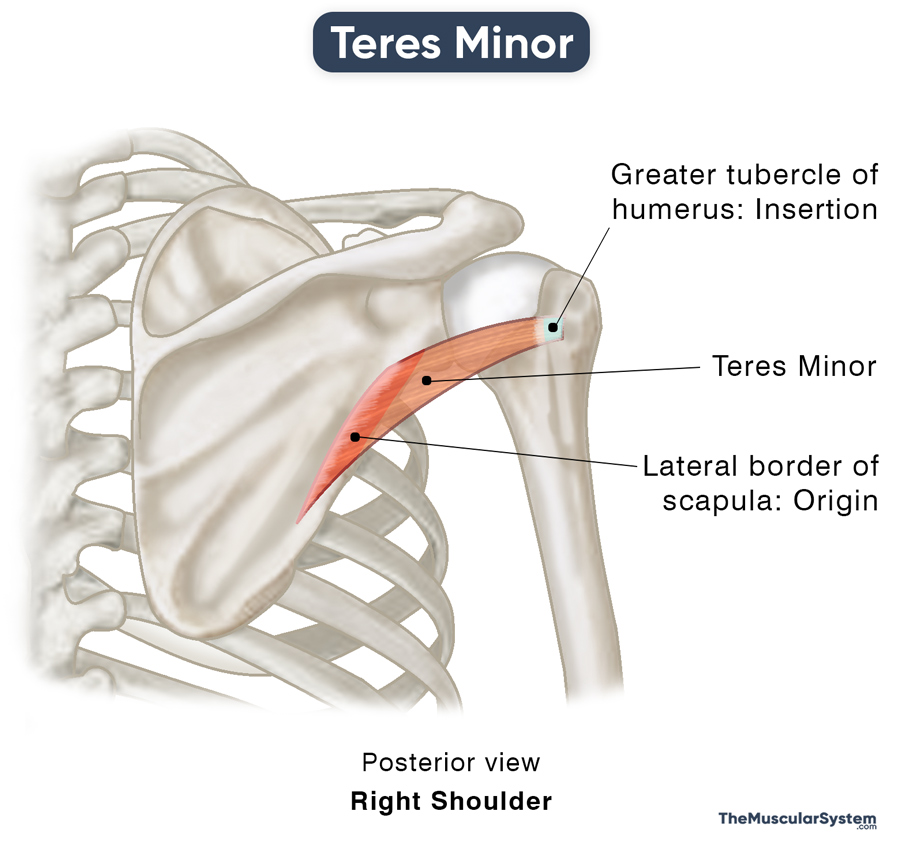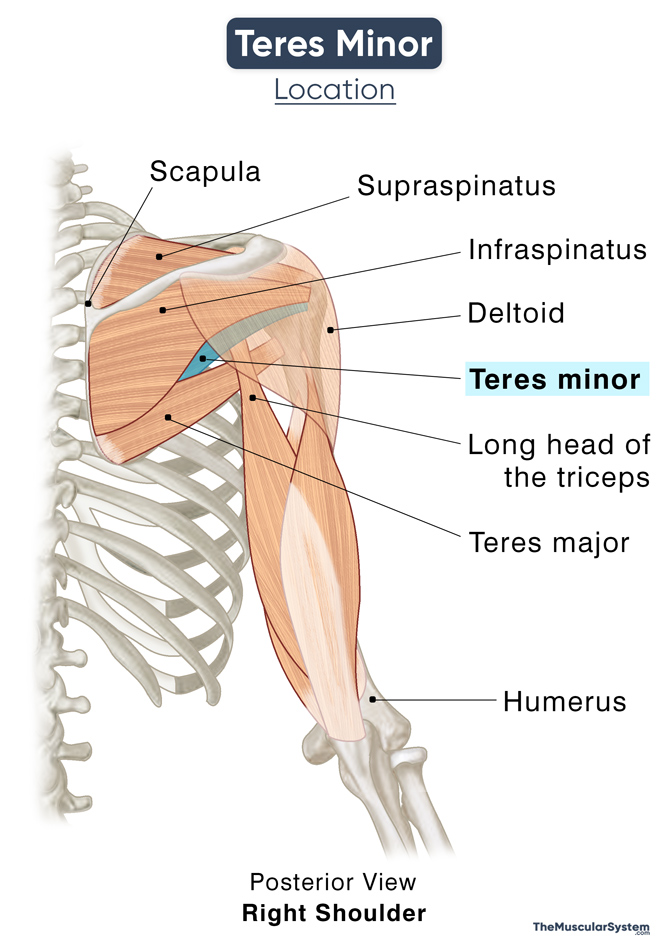Teres Minor
Last updated:
27/05/2024Della Barnes, an MS Anatomy graduate, blends medical research with accessible writing, simplifying complex anatomy for a better understanding and appreciation of human anatomy.
What is the Teres Minor
The teres minor is a narrow, cylindrical muscle in the shoulder that makes up the rotator cuff along with 3 others, the infraspinatus, supraspinatus, and subscapularis. Its name derives from its size and appearance, as ‘teres’ means ‘round’ (referring to its cylindrical shape), and ‘minor’ means ‘small.’
Anatomy
Location and Attachments
| Origin | The middle one-third of the lateral scapular border |
| Insertion | The lower surface of the greater tubercle of humerus |
Soon after originating from the lateral border of the scapula, the muscle fibers fuse together to form the muscle belly that runs upward and outward to insert into the greater tubercle in the proximal humerus.
Relations to Other Muscular Structures
The teres minor is located deep to the deltoids and superior to the long head of the triceps, perpendicular to it. The small muscle lies between the teres major below and the infraspinatus above. All three have an oblique orientation in the shoulder. In a rare anatomical variation, the teres minor muscle may fuse with the infraspinatus.
It is covered by the deltoid muscle on its superolateral side, while the spine muscle trapezius partially covers the medial surface.
Like the other three muscles in the rotator cuff, the teres minor tendon blends into the shoulder capsule to stabilize and strengthen the joint.
The muscle also participates in the formation of two of the three axillary spaces, namely the quadrangular and triangular spaces. The long head of the triceps, teres major, and the body of the humerus are also involved in forming these three spaces.
Functions
| Action | Lateral rotation, and adduction (weakly) of the arm at the shoulder joint Stabilizing the shoulder joint |
1. Stabilizing the shoulder: As a rotator cuff muscle, its primary action is to help tightly hold the head of the humerus or the ‘ball’ inside the scapula’s glenoid cavity or the ‘socket’ to stabilize the ball-and-socket shoulder/glenohumeral joint. It allows all sorts of shoulder and arm movements without the joint falling apart.
2. Arm rotation: The teres minor helps rotate the upper arm laterally or outwards at the shoulder joint. The infraspinatus muscle helps it in this action. An example of the movement is when you pull a door open or spread your palm in front of you. Since it works as a lateral rotator, it is antagonistic to rotating the arm medially or inwards. So, it plays an essential role in preventing dislocation of the humerus at the shoulder during a medial rotation.
3. Adduction: The muscle also works as a weak adductor, helping the teres major, pectoralis major, and latissimus dorsi in bringing an extended arm back towards the side of the body. It is used during actions like throwing a ball or doing jumping jacks.
The primary antagonists of teres minor are pectoralis major, subscapularis, deltoid, trapezius (middle), and latissimus dorsi.
Innervation
| Nerve | Axillary nerve (C5 and C6) |
The muscle has the same innervation as the deltoid. The axillary nerve that supplies the teres minor is a branch of the posterior cord of the brachial plexus.
Blood Supply
| Artery | Subscapular, circumflex scapular, and posterior circumflex humeral arteries |
The subscapular and posterior circumflex humeral arteries are branches of the axillary artery. The circumflex scapular artery branches from the subscapular artery.
References
- Teres Minor Muscle – Attachments, Actions & Innervation: GetBodySmart.com
- Teres Minor Muscle: KenHub.com
- Teres Minor: TeachMeAnatomy.info
- Anatomy, Shoulder and Upper Limb, Arm Teres Minor Muscle: NCBI.NLM.NIH.gov
- Teres Minor Muscle: IMAIOS.com
- Teres Minor Muscle: RadioPaedia.org
- Teres Minor: Rad.Washington.edu
- Teres Minor Muscle: Action, Origin & Insertion: Study.com
Della Barnes, an MS Anatomy graduate, blends medical research with accessible writing, simplifying complex anatomy for a better understanding and appreciation of human anatomy.
- Latest Posts by Della Barnes, MS Anatomy
-
Geniohyoid
- -
Digastric
- -
Stylohyoid
- All Posts







